Cecilia Paredes emailed me at the Weekly not too long ago. The Peruvian-born artist, now living in Philadelphia, wanted to tell me about her pieces included in the Venice Biennale. Local artist in the Venice Biennale? How’s that?
One of the images Paredes sent along was an installation shot of one of the Venice pieces. It was of a large photo printed on acetate and installed in a window of what looked like a church. The photo depicts an enormous human-headed gargoyle as if ready to spring forward, a rather disturbing image both pagan and somehow holy. I suggested we have coffee so I could learn more.
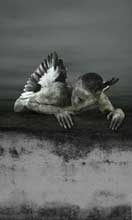
The artist is a new arrival in Philadelphia, having moved here after her marriage a year and a half ago to Jay Reise, a composer based at the University of Pennsylvania (he’s president of Orchestra 2001 and Paredes told me he just won a prestigious Aaron Copeland Fund for Music grant.)
She explained that her art is performance-based and that the gargoyle was a photo of her, made up in grey face and with sculpted hair. The idea behind the work relates to the idea of mystical metamorphosis — the union of humans and animals in a dream consciousness we all share. I am reminded of the magical realism of Frida Kahlo and others which have an internal logic based on poetry and the senses and not so much on the hard knocks of day to day existence.
Paredes poses for the camera using costumes and props and makeup that transform her. The work is seen only in photographs not in the “real” world. She told me that her transformation often delivers her to the point of tears as she poses in crouches that twist and turn her body. But the tears come not just from body fatigue — how long can you hold some of these poses before cramping up, ask yourself — but from the attempt to immerse herself into the other being she’s conjuring for the camera. Empathy for the world’s lesser creatures might seem to us in the west like misplaced empathy but for someone on a journey into the dream world which is beyond ego, all creatures are worthy, and without empathy there is nothing. (You can see more of her works on her website.)
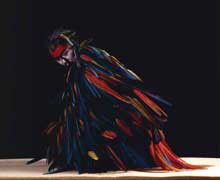
Paredes works in what she considers a collaboration with her photographers. She’s worked with three photographers in three different locations, Lima, San Jose, Costa Rica, and now in Philadelphia. In Philadelphia she’s working now with Alfred Pfaff, semi-retired, age 70. She’s thrilled Pfaff agreed to work with her. “He listens. He’s not in a hurry. And he made it affordable for me,” she said about the respected Philadelphia-area photographer. She’s working now on a new series. Not demons, she said, although fierce they will be: Medusa, Hydra and Pandora. (image is “Papagallo,” a piece also shown at the Venice Biennale. The feathers are parrot feathers from a bird sanctuary in Costa Rica. The sanctuary harvested the dropped feathers from the grounds of the complex. )
Paredes, who shows her work with Miami’s Diana Lowenstein Gallery, recently returned from Miami where she was preparing for the gallery’s booth in Art Basel Miami opening Dec. 4.
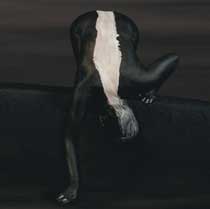
I asked her about her roots as an art maker. Did she come from the theater? The work is highly theatrical and even though the performance is private (between her, the photographer and the camera) it is indeed a performance requiring her to get into character and transform her body into something other than what it naturally is.
“I was formed as an artist in the traditional way. So I know all the disciplines. I have done some painting. I consider myself a drawer, a sculptor. And now I transform myself into animals — fantastic animals.
(image is “Curious little fox”)
Right now in fact she’s studying filmmaking, enrolled in a course at Penn taught by Paul Buck. “It involves a lot of computers” she said, clearly smitten with the possibilities for her art. She was propelled into the world of video by seeing several pieces in Venice, one by Panamanian filmmaker Brooke Alfaro, “Aria” and another by Donna Conlon — “Coexistencia,” that one involving an army of leaf carrier ants who have been outfitted to parade in line in ant fashion with the flags of the world on their backs instead of leaves. It was videotaped at close range and with sound (crunching twigs etc).
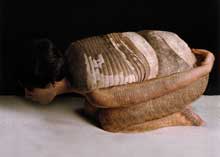
I asked Paredes about doing her body-shifting photos. She says she gets herself into the spirit of the animal. It’s difficult and requires an enormous amount of focus. For the armadillo piece she used 3 armadillo skins and then she Photoshopped the pattern on the rest of her body. (image is the armadillo piece)
She thought one time she would like to be a snake to exorcise her fear of them. “Snakes go under sand so I bought 300 lbs of sand and buried myself under the sand.’
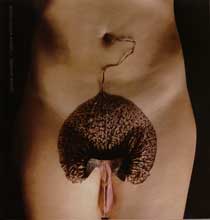
The oddest photo in her ouervre is one that involves not an animal but a flower — the aristolochea which she said, is “a perfect hermaphrodite, and that’s my focus — transgression.” (image is the flower piece. She told me the flower is a fly trap but not carnivorous. It traps the insect for pollination purposes then expels it once the pollination is done.)
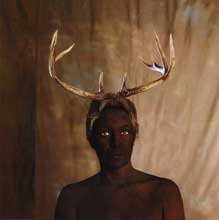
Paredes handed me a catalog of her work and we went through the pages looking at the various animals.
Of the deer, she said. “That’s from being in Canada. There was no Photoshop to do the eyes. The eyes pop just from the skin being so dark.” (image left)
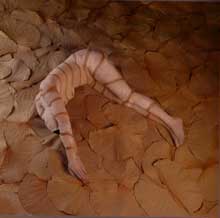
About the shrimp image (right) : “It’s with lotus leaves from Vietnam. I collect things from my travels and re-use them.”
I asked her about her connection with animals and she explained that she grew up in Lima and each year they spent three months at the shore. “I spent summers looking at little shells. I wanted to be a fish. Now I’m trying to be the fish I once was,” she said.
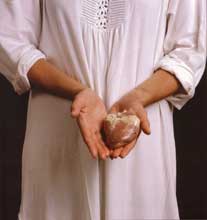
About the heart (left) : “It’s a sheep heart. The closest in form and shape to a human being.”
“The dragonflies were the first,” she said, meaning it was the first time she had applied animal parts (or insect parts) to her body.
(right)
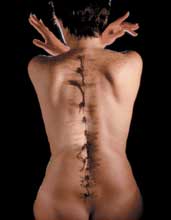
“It was to declare that I am recognizing that I have wings and I can fly. For me these were very important and the beginning of everything.”
“My career started in 1996 or 1997. In 1996 I went to the Havana Biennial. It was very important for me. The reason I started so late (she was born in 1950) was because I was a gypsy, living all over the world. When I settled in Costa Rica (some 20 years ago) I settled on a body of work. I am working 10 hours a day as an artist. I’ve been drawing (all my life) but not until then did I feel “this is it.”
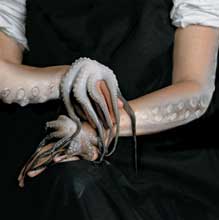
Paredes’ works are beautiful and eerie. They take you on a little journey into yourself where your real world experience of things like dragonflies, deer and octopi comes up against a dream world that feels true even when not real. Paredes’ gestures in her works are selfless, in spite of her use of self as vehicle to express her art. What she’s tapped into by merging her ego and body with that of our animal, vegetable and underwater friends is a great collective unconscious desire to merge and be one with the world.
Paredes is a quiet woman with an easy smile and an earnest quality. But her work is full of a kind of fierceness you find in one who knows herself and feels her subject deeply. Welcome to Philadelphia, Cecilia!
(image is Paredes’ “Octopus Hands,” a photo I think is one of her most beautiful, edgy and evocative.)









